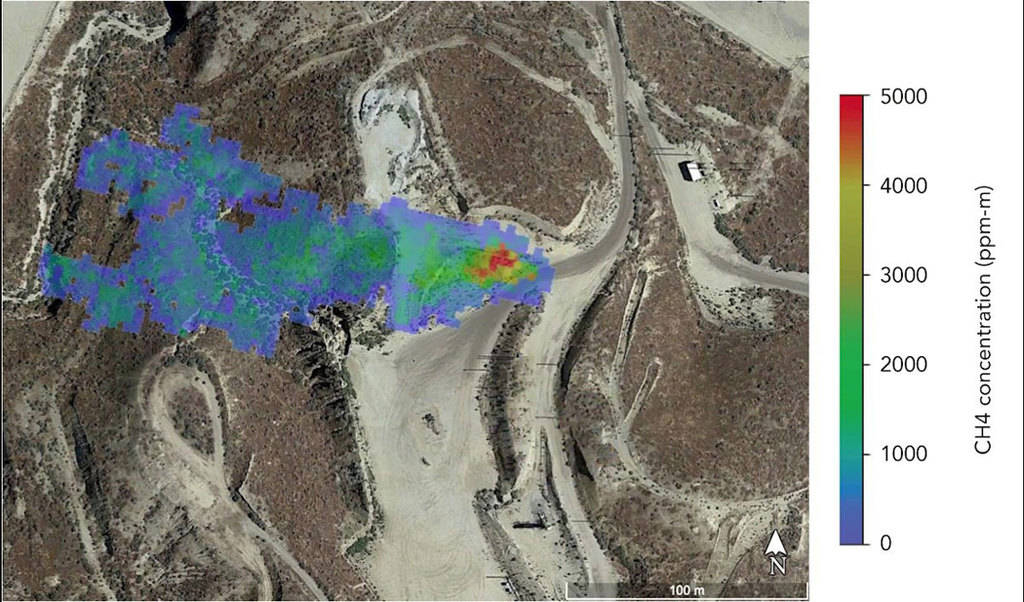Cracking Down on Methane Emissions
Posted on December 13th, 2021
Posted in Uncategorized

Photo Credit: NASA/JPL-Caltech.
Methane has been in the spotlight of the Climate Change discussion as of late. More than 100 countries pledged, including the U.S., to reduce methane emissions by 30% from 2020 to 2030. In addition, the EPA has proposed changes to emission regulations forNew Source Performance Standards (NSPS). These pledges and proposed changes particularly affect Oil and Gas, as the largest source of industrial methane emissions.
Taking a step back, why are methane emissions important? There are four major categories of greenhouse gases (GHG): carbon dioxide, methane, nitrous oxide, and fluorinated gases. Carbon dioxide is by far in a way the most commonly emitted molecule, however, each gas has its own global warming potential (GWP) and its own atmospheric half-life. For methane, the GWP is 25X more than carbon dioxide over a 100-year period. Methane being a valuable product (primary component in natural gas) coupled with the fact that there are cost effective ways of reducing methane emissions (combustion), it’s a logical target for regulation.
The EPA proposed change covers 40 CFR Part 60 Subpart OOOOa (existing), Subpart OOOOb (new), Subpart OOOOc (new). The OOOOa (Quad Oa) proposed rule aims to revert the methane standards to the original 2016 regulation. Quad Ob and Quad Oc are integrally related with Quad Ob imposing standards and Quad Oc providing emission guidelines intended to advise State level authority so that decisions can be made adhering to emission reduction standards. These new rules will impact new, modified, and/or reconstructed sources. In the following breakdown, we’ll focus on surface facility related items around zero-emitting pneumatic controllers, pneumatic pumps, and strengthened requirements for storage tanks. However, operators should be aware that these regulations also extend to fugitive emissions, well unloading, completions, associated gas, equipment leaks, and compression.
- Zero-emitting pneumatic controllers – The proposed rule adds intermittent vent controllers as an affected facility and states continuous bleed and intermittent vent must be zero-emitting for methane and VOCs. Currently, zero bleed controllers are only required at natural gas processing plants. Elsewhere the bleed rate is limited to 6 scfh.
- Pneumatic pumps – The proposed rule adds natural gas driven piston pumps and natural gas driven pneumatic pumps at transmission and storage facilities to the affected facilities. Currently only natural gas driven pneumatic pumps at well sites require 95% control of emissions.
- Storage Tanks – The proposed rule would change how the affected facility threshold is determined with 6 tpy being calculated based on the aggregate potential to emit for the entire tank battery as opposed to a single storage vessel.
At Halker, we can help aid in compliance to these regulations or other ESG initiatives through: a) evaluation of alternatives to pneumatic controllers or pumps, b) working with flare vendors to ensure destruction efficiency of flare systems are adequate, c) supporting selection of thief hatches, PSVs, or other potential fugitive emission sources, and d) through adequate design we can reduce the probability of major release events by performing safety reviews, process hazard analysis, and pre-start up safety reviews. Outside of regulatory compliance, striving towards maximizing methane capture promotes public relations and can affect the bottom line through increased sales volume.
 Curtis Anderson is a seasoned Projects Director at Halker, specializing in managing projects for electric utilities and renewable energy companies, including high voltage power, solar, wind, and battery energy storage systems (BESS). Prior to his current role, Curtis held various leadership positions with 12 years in the industry. As Technology Innovation Manager, he was instrumental in establishing and leading a Product and Innovation team within the Power and Renewables Industry, driving technology enablement initiatives, and fostering a culture of innovation. His work included guiding the development of new products, implementing AI-driven solutions, and supporting the launch of industry-first SaaS offerings. Curtis also played a key role in business-to-business collaborations, strategic planning, and served as a member of an Artificial Intelligence Governance Board, focusing on enhancing operational efficiency through technology and R&D efforts.
Curtis Anderson is a seasoned Projects Director at Halker, specializing in managing projects for electric utilities and renewable energy companies, including high voltage power, solar, wind, and battery energy storage systems (BESS). Prior to his current role, Curtis held various leadership positions with 12 years in the industry. As Technology Innovation Manager, he was instrumental in establishing and leading a Product and Innovation team within the Power and Renewables Industry, driving technology enablement initiatives, and fostering a culture of innovation. His work included guiding the development of new products, implementing AI-driven solutions, and supporting the launch of industry-first SaaS offerings. Curtis also played a key role in business-to-business collaborations, strategic planning, and served as a member of an Artificial Intelligence Governance Board, focusing on enhancing operational efficiency through technology and R&D efforts. Shannon McKibben is the director of Environmental Engineering at Halker, executing environmental, health, and safety projects for clients in construction, oil & gas, transportation, and power delivery. Under Shannon’s leadership, Halker’s Environmental Engineering group is actively diversifying from its historical role serving primarily road and highway construction clients into a support group for all of Halker’s projects, focusing on energy delivery and development.
Shannon McKibben is the director of Environmental Engineering at Halker, executing environmental, health, and safety projects for clients in construction, oil & gas, transportation, and power delivery. Under Shannon’s leadership, Halker’s Environmental Engineering group is actively diversifying from its historical role serving primarily road and highway construction clients into a support group for all of Halker’s projects, focusing on energy delivery and development. Dominic brings over 15 years of leadership in privately held and PE‑backed firms. Dominic’s experience in the energy industry expands across several sectors, including refining, midstream & pipeline and delivering fully modular facility solutions in the upstream production arena. Dominic has been involved in the sales and project management of more than 30 fully modular facilities in the Permian basin. He has built scalable go‑to‑market strategies that have helped drive impressive revenue growth: from $10M to $25M at Welker, and launching Petrosmith’s Modflex line to $40M in three years, while more than doubling revenue with its largest client.
Dominic brings over 15 years of leadership in privately held and PE‑backed firms. Dominic’s experience in the energy industry expands across several sectors, including refining, midstream & pipeline and delivering fully modular facility solutions in the upstream production arena. Dominic has been involved in the sales and project management of more than 30 fully modular facilities in the Permian basin. He has built scalable go‑to‑market strategies that have helped drive impressive revenue growth: from $10M to $25M at Welker, and launching Petrosmith’s Modflex line to $40M in three years, while more than doubling revenue with its largest client. 




 Philip Barr joined Halker in April 2023. With nearly 20 years of structural engineering experience, he has contributed to projects across the oil and gas, pharmaceutical, chemical, mining and metals, and manufacturing industries. Philip has successfully led structural design teams in executing projects totaling over one billion dollars in value. He has also worked internationally as a field engineer and client representative, gaining valuable experience in constructability, modular design, and retrofit construction. As Halker’s Director of Structural Engineering, Philip draws on his extensive background and technical expertise to deliver innovative and cost-effective structural solutions for clients across a wide range of industries.
Philip Barr joined Halker in April 2023. With nearly 20 years of structural engineering experience, he has contributed to projects across the oil and gas, pharmaceutical, chemical, mining and metals, and manufacturing industries. Philip has successfully led structural design teams in executing projects totaling over one billion dollars in value. He has also worked internationally as a field engineer and client representative, gaining valuable experience in constructability, modular design, and retrofit construction. As Halker’s Director of Structural Engineering, Philip draws on his extensive background and technical expertise to deliver innovative and cost-effective structural solutions for clients across a wide range of industries.
 Cory Shattuck is the Vice President of Power Services at Halker, based in Centennial, Colorado. With a career spanning roles such as Director of Power Delivery, Utility-scale Solar Technical Manager, Substation Technical Manager, and various engineering positions, Cory brings a wealth of experience to the energy sector. Cory’s expertise includes substation design, medium-voltage underground collection systems, electrical studies, and relay settings. In his current role, he leads the Power Services division, overseeing project execution, technical excellence, and strategic growth. His leadership is grounded in a commitment to quality, safety, and innovation in power delivery solutions. He has served as a Quality Manager for a key client and contributed to both Quality and Safety Committees. Cory holds a Bachelor of Science in Electrical Engineering from the South Dakota School of Mines and a Master of Business Administration from Colorado State University. He is also a licensed Professional Engineer.
Cory Shattuck is the Vice President of Power Services at Halker, based in Centennial, Colorado. With a career spanning roles such as Director of Power Delivery, Utility-scale Solar Technical Manager, Substation Technical Manager, and various engineering positions, Cory brings a wealth of experience to the energy sector. Cory’s expertise includes substation design, medium-voltage underground collection systems, electrical studies, and relay settings. In his current role, he leads the Power Services division, overseeing project execution, technical excellence, and strategic growth. His leadership is grounded in a commitment to quality, safety, and innovation in power delivery solutions. He has served as a Quality Manager for a key client and contributed to both Quality and Safety Committees. Cory holds a Bachelor of Science in Electrical Engineering from the South Dakota School of Mines and a Master of Business Administration from Colorado State University. He is also a licensed Professional Engineer.



